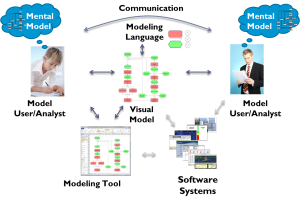- Project “Investigating Flow Direction of Business Process Models with Eye Tracking” funded by the Vienna University of Economics and Business (3850 Euro), 2 employees with 135 working hours, 2016-2017 [Principal Investigator]:
A core aspect of diagrammatic process modeling is the visualization of the logical and temporal order in which tasks are to be performed in a process. While conventions and guidelines exist that promote modeling processes from left-to-right or from top-to-bottom, they do not give a clear recommendation which flow direction to choose. Therefore, this project seeks to determine whether the left-to-right flow direction is superior to the top-to-bottom direction from a cognitive point of view and how model readers adapt to changes in reading directions. Prior empirical studies on flow direction based on global model comprehension tasks were inconsistent and suffered methodologically from imprecise measurement of time. To address these shortcomings it is inevitable to exactly measure the point of gaze of model readers. Therefore, a controlled eye-tracking experiment comparing the effects of these two commonly used flow directions on process model comprehension with a sample size of approximately 80 participants is planned. The expected results can serve as guidance for selecting the optimal flow direction in process modeling practice and inform future standardization efforts.
- Dr.-Maria-Schaumayer Research Grant from Austrian Nationalbank (OeNB) for the project “Cognitive Effectiveness in Business Process Modeling” (55000 Euro), 2014-2015 [Principal Investigator]:
Process models have been recognized as an effective means for documenting and communicating business processes, and especially for discussing stakeholders’ different viewpoints on large-scale endeavors such as the redesign of business processes or the analysis and design of process-aware information systems. Even though models reduce complex business processes to their essential components in order to “bring clarity and understanding to some aspect of a problem where there is complexity, uncertainty, change or assumptions”, the creation and comprehension of process models still requires high cognitive effort itself, due to the limited information processing capabilities of the human brain. Prior contributions to the area of process model comprehension are limited and have only examined scattered influence factors in isolation. As of now, a comprehensive body of knowledge that might assist process model practitioners in developing intuitive and understandable process models has been lacking. Thus, the main objective of the project is to provide a richer understanding of cognitive effectiveness in process modeling by performing a series of experiments to investigate relevant influence factors which have not yet been addressed by the research. The project intends to contribute a deepened and contextualized body of knowledge around process modeling comprehension as well as process model improvement.
- Project “Creative Business Process-Redesign” funded by the Vienna University of Economics and Business (3300 Euro), 2 employees with 124 working hours, 2011-2012 [Principal Investigator]:
Supporting business analysts with process models in idea generation tasks has been a longstanding topic of interest. This project examines how two types of models about organizational processes – textual or diagrammatical – assist analysts in developing innovative solutions to process redesign tasks. The results from the project clarify which types of process redesign ideas are being generated by analysts working with texts or models. A main result of the project was that volume or originality of process redesign ideas does not differ significantly but appropriateness of ideas varies.
- Visiting Fellow Scholarship from the Vienna University of Economics and Business for a research stay at the Business Process Management group, University of Queensland, Brisbane, Australia (5000 Euro), 2010


